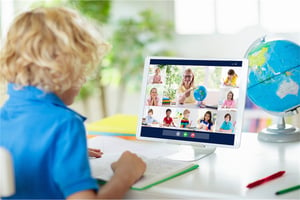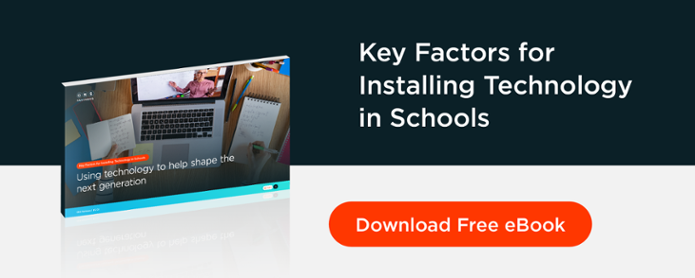
For many school districts, the looming question on the horizon is: what will happen for the remainder of this year? The Corona Virus does not seem to be slowing down and online classes are getting harder and more burdensome to teach. Teachers and students alike need a better solution.
Blended learning models—in which classrooms become hybrids of both live and remote learners due to social distancing—seem to be the best answer for many schools. Having any face-to-face learning, with more teacher supervision and engagement, seems better than none, but it still raises further questions and potential problems. How do we ensure that this hybrid model is fair; that this learning model doesn’t give an automatic advantage to the in-person learners? And how can we make this learning environment feel communal when a classroom is split so divisively? How does a classroom educator craft a lesson plan that can translate seamlessly for both online and in-person students?
Finding a solution
In order to find a solution to all of these questions, the focus needs to be on improving the technology. After all, the remote-learners are far more likely to struggle with engagement and understanding than the in-person learners, who feel naturally more immersed in the classroom. Though some students can learn effectively online, on average, studies show that students do worse in an online setting, and this is especially true if they already struggle academically. Not only is self-motivation and discipline difficult with less access to teachers and classmates; teaching itself is challenging to make engaging from the vantage point of a pixelated, 2D screen. Teaching is always the most absorbing and effective when it’s dynamic, when teachers can move and demonstrate, fueled by questions and class discussions, and that has been nearly impossible to replicate through video calls. Therefore, what these classrooms need is a way to elevate the technology so that remote students can feel engaged, included, and supervised.
 The key, then, is to utilize technology that goes above and beyond a static camera. The ideal technology can capture a 360-degree video and audio experience, through a small, speaker-like device, the camera shifting to highlight whoever is speaking, creating a holistic classroom experience for remote students. This allows for class discussion to feel more natural and collaborative, and it makes remote students feel far more included. The shifting of the camera also means that teachers or teaching assistants don’t have to be constantly adjusting a camera or computer, which makes the teaching—and the learning—much more fluid.
The key, then, is to utilize technology that goes above and beyond a static camera. The ideal technology can capture a 360-degree video and audio experience, through a small, speaker-like device, the camera shifting to highlight whoever is speaking, creating a holistic classroom experience for remote students. This allows for class discussion to feel more natural and collaborative, and it makes remote students feel far more included. The shifting of the camera also means that teachers or teaching assistants don’t have to be constantly adjusting a camera or computer, which makes the teaching—and the learning—much more fluid.
Let's help teachers
Teachers have enough on their plates right now with re-creating their remote learning lesson plans to include well-designed online courses, and this technology should be helping them without requiring additional complications or wasting any class time. Luckily, this technology doesn’t have to be complicated. It’s as simple as logging onto familiar video platforms—like Zoom or Microsoft Teams—and then connecting that with one of these conferencing systems that include a 360 degree camera and autofocus. This video feed can even be integrated onto a Smartboard by logging onto the system on a computer, and then connecting them with a cable. This way, remote students can be seen and heard just as clearly as the in-person students, with their placement at the front of the classroom. And for classrooms without Smartboards, this can be set up just as easily on a video projector.
This creates a better-connected classroom for the students, but it can also be revolutionary for the teachers themselves. After setting up this 360-degree technology, teachers don’t have to keep checking in on the camera—they can just teach. They can move through the classroom and not be isolated behind a podium. They can use white boards or chalk boards to write equations, to show examples. In science classes, teachers can use test tubes, or other equipment to demonstrate experiments. In art classes, teachers can show examples and techniques on an easel. All of the different components of teaching can be enabled and strengthened through having more immersive technology in the classroom.
Always working to improve
The speed at which schools managed to rework their curriculums onto online platforms was so impressive, but this model has to keep adjusting. As problems with remote learning crop up, and many classrooms continue to move from being fully online to hybrid models, it’s important that schools keep adapting to create cohesive learning environments. Students need instruction that is innovative, engaging, and unifying, that goes beyond two-dimensional lectures that are difficult to focus on. Teachers need well-rounded technology that allows for them to teach freely and without complications. These needs are multi-faceted, and this mix of familiar video conferencing systems with newer, 360-degree camera and speaker systems, creates the ideal solution for bringing together students and teachers in the classrooms.
Our young students are impressionable and need to be able to learn as much as they can, no matter what is happening in the world around us. Learn how you can implement modern technology in your classroom with our Educational IT Services. We help educators find affordable solutions to augment teaching in their classrooms.



